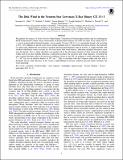The Disk Wind in the Neutron Star Low-mass X-Ray Binary GX 13+1
Author(s)
Allen, Jessamyn Leigh; Homan, Jeroen; Neilsen, Joseph M. G.; Chakrabarty, Deepto; Schulz, Norbert S.; Nowak, Michael A.; ... Show more Show less
DownloadAllen_2018_ApJ_861_26.pdf (1.214Mb)
PUBLISHER_POLICY
Publisher Policy
Article is made available in accordance with the publisher's policy and may be subject to US copyright law. Please refer to the publisher's site for terms of use.
Terms of use
Metadata
Show full item recordAbstract
We present the analysis of seven Chandra High Energy Transmission Grating Spectrometer and six simultaneous RXTE Proportional Counter Array observations of the persistent neutron star (NS) low-mass X-ray binary GX 13+1 on its normal and horizontal branches. Across nearly 10 years, GX 13+1 is consistently found to be accreting at 50%-70% Eddington, and all observations exhibit multiple narrow, blueshifted absorption features, the signature of a disk wind, despite the association of normal and horizontal branches with jet activity. A single absorber with standard abundances cannot account for all seven major disk wind features, indicating multiple absorption zones may be present. Two or three absorbers can produce all of the absorption features at their observed broadened widths and reveal that multiple kinematic components produce the accretion disk wind signature. Assuming the most ionized absorber reflects the physical conditions closest to the NS, we estimate a wind launching radius of 7 ×10¹⁰ cm, for an electron density of 10¹² cm⁻³. This is consistent with the Compton radius and also with a thermally driven wind. Because of the source's high Eddington fraction, radiation pressure likely facilitates the wind launching.
Date issued
2018-06Department
Massachusetts Institute of Technology. Department of Physics; MIT Kavli Institute for Astrophysics and Space ResearchJournal
Astrophysical Journal
Publisher
IOP Publishing
Citation
Allen, Jessamyn L. et al. “The Disk Wind in the Neutron Star Low-Mass X-Ray Binary GX 13+1.” The Astrophysical Journal 861, 1 (June 2018): 26 © 2018 The American Astronomical Society
Version: Final published version
ISSN
1538-4357
0004-637X